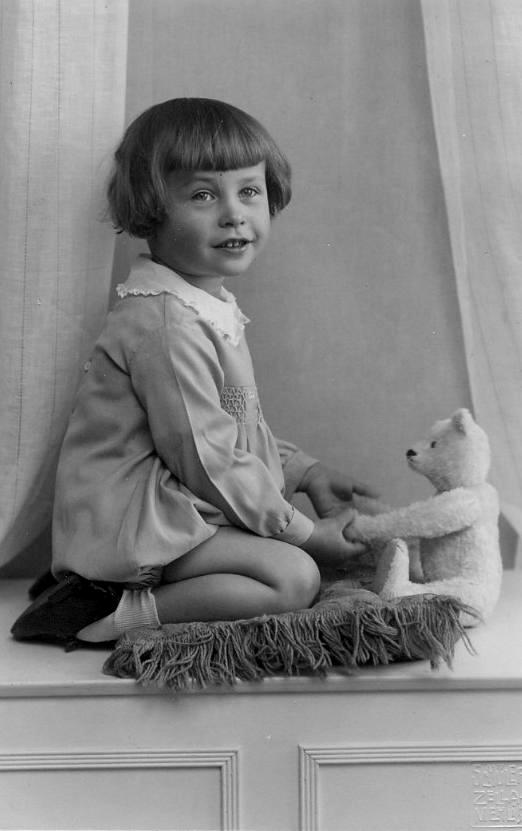
German Boys' Clothes: Romper Conventions/Usage

Figure 1.--This German portrait was taken in 1928. The child wears a dressy romper with a ruffled collar and front smocking. It was dome without a waistline. We think the child with Dutch boy bangs is a boy, but we are not positive. Teddies were mnore common for boys, but some girls had them as well.
|
|
Rompers were a simple, flexible one-piece style for boys. They seem to have been primarily a play garment, an easy way for mothers to dress little boys for play or casual wear. The romper play suits tend to be plain and practical. We see many different styles of play rompers. This mean primarily outdoor play during the summer. Thus included both roper suits and rompers with bib fronts. Play rompers were made in practical fabric, either durable or inexpensive fabrics. Some boys just wore the romper pants. We also note boys wearing rompers for dress up occassions as well. These rompers might be made in expensive, plushy materials. They often had fancy touches such as large or ruffled clcollars and front smocking. The vast majority of the German images we have found show children wearng rompers as play garments. The dressier rompers we have found in France seem much less common in Germany. They do not seem to have been nearly as popular as a dressy garment. We have found a few dressy rompers, but not many in Germany. Here age was a factor, many of the dressy rompers we see were for younger boys.
Rompers were a simple, flexible one-piece style for boys. They seem to have been primarily a play garment, an easy way for mothers to dress little boys for play or casual wear. The romper play suits tend to be plain and practical. We see many different styles of play rompers. This mean primarily outdoor play during the summer. Thus included both roper suits and rompers with bib fronts. Summer rompers for the summer were made with bib fronts or sometimes no bib at all. This made for a comfortable garment in hot summer weather. Play rompers were made in practical fabric, either durable or inexpensive fabrics. We see both solid colors and patterns. Some boys just wore the romper pants. The vast majority of the German images we have found show children wearng rompers as play garments.
We also note boys wearing rompers for dress up occassions as well. These dressy rompers might be made in expensive, plushy materials. We see both rompersuits and suspender rompers. The romper suits might have the dressy, decorative touches incorporated as part of the romper. They often had fancy touches such as large or ruffled collars and front smocking. They might be worn with fanbcy collars like the rompersuit the boy here is wearing (figure 1).
We also notice suspender rompers. Here the decorative touches were not on the romper pants, but were part of the blouse worn with the rompers. This might include a fabcy Fauntleroy blouse or a plainer garment, more like a basic white shirt. The dressier rompers we have found in France seem much less common in Germany. They do not seem to have been nearly as popular as a dressy garment. We have found a few dressy rompers, but not many in Germany. Here age was a factor, many of the dressy rompers we see were made for younger boys. We mnote both romper suits as well as strap rompers worn with a blouse.
HBC

Navigate the Boys' Historical Clothing German pages:
[Return to the Main German romper page]
[German art]
[German choirs]
[German movies]
[German royalty]
[German school uniforms]
[German youth groups]
[German sailor suits]
[Lederhosen]
[Ethnic]
[Tights]
[Long stockings]
Navigate the Boys' Historical Clothing Web Site:
[Introduction]
[Activities]
[Biographies]
[Chronology]
[Clothing styles]
[Countries]
[Bibliographies]
[Contributions]
[Essays]
[FAQs]
[Glossaries]
[Images]
[Links]
[Registration]
[Tools]
[Boys' Clothing Home]
Created: 2:48 AM 1/7/2009
Last updated: 10:48 PM 5/17/2017



